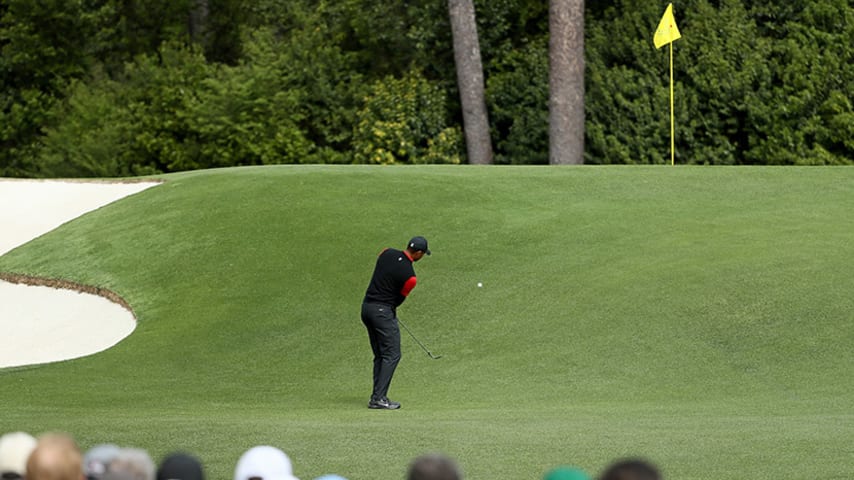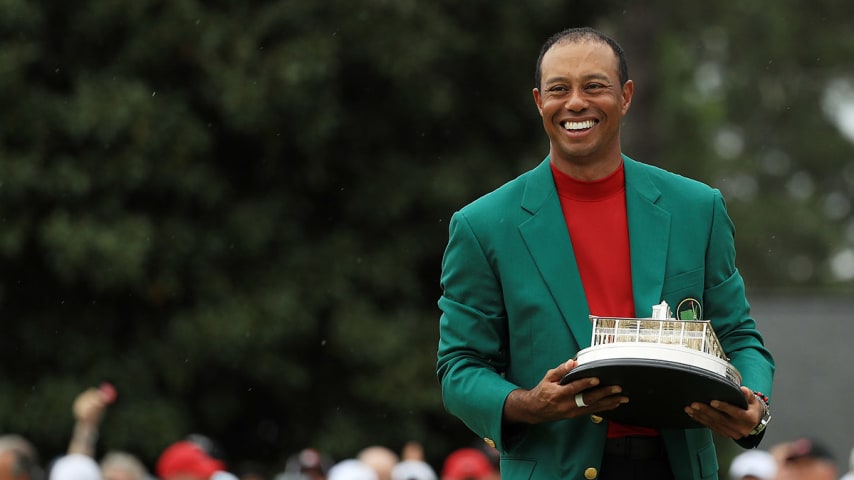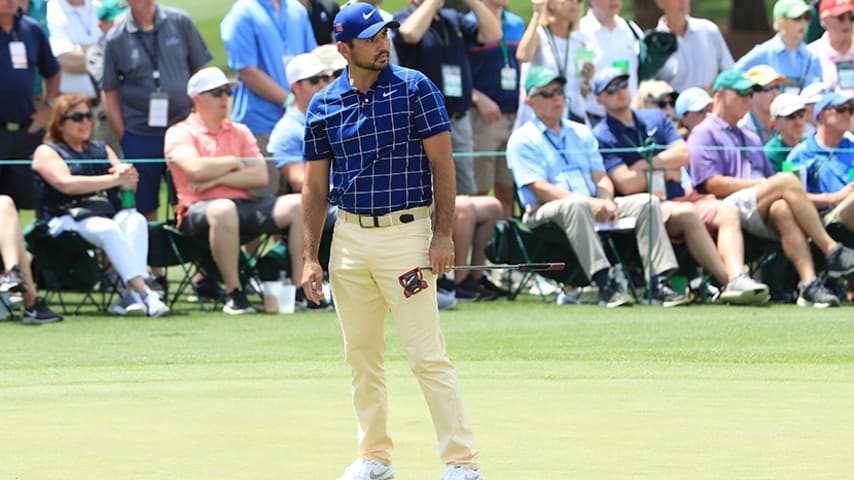Five stats to consider for the Masters Tournament
6 Min Read

AUGUSTA, GA - APRIL 08: Tiger Woods of the United States plays his third shot on the third hole during the final round of the 2018 Masters Tournament at Augusta National Golf Club on April 8, 2018 in Augusta, Georgia. (Photo by Jamie Squire/Getty Images)
Written by Sean Martin
AUGUSTA, Ga. – Statistics have an ever-expanding role on the PGA TOUR, but the Masters is one week when artistry and elegance are emphasized over analytics. The flora and fauna of this former nursery provide an unmatched beauty, while the slick putting surfaces and severe slopes of Alister Mackenzie’s design require players to exhibit a delicate touch.
RELATED:Tee times | How to Watch | Expert Picks | Power Rankings | Pros talk hole-by-hole | Tiger's equipment
“I think one of the great things about this course is it forces you to be creative,” Rory McIlroy said in his pre-tournament press conference. “The massive, tall pines, the contrast between green grass and the white bunkers, the yellow flagsticks, there’s so many things to look at and be aware of. It paints a picture for you.”
That doesn’t mean that the numbers should be ignored, though. So, on the eve of the Masters, here are five interesting statistics to consider.
1. Augusta National is known as a course that can produce large swings in scoring, especially on Sunday. The par-5s offer eagle opportunities while penalizing missteps. The sloping greens have swales that can funnel well-played shots toward hole locations while leaving difficult putts and chips for those on the wrong side of the ridges.
To get a better look at where Masters champions distance themselves from the field, I looked at the Strokes Gained in the last 10 years by the players who have led the Masters after 72 holes (winners and playoff participants. That’s a total of 15 players and 60 rounds.
The leaders were two holes – Nos. 3 and 14 -- that are often overshadowed by some of their more famous brethren.
“I wouldn’t have guessed 3 and 14, but it makes a lot of sense because those holes can be a tap-in 3 or a quick 5 or 6 if you hit it in the wrong spot,” said one longtime TOUR caddie.
The third hole is the shortest par-4 on the course. One player, Tommy Fleetwood, even drove it last year. But large fairway bunkers protect the left side of the fairway and the left side of the green is protected by a deep swale. Many players use nothing more than a long-iron off the tee and have a wedge into the green, but the penalties can be severe if they don’t execute either shot.
No. 14 is often overlooked because it sits between the second nine’s two famous par-5s. The 14th also is the only hole on the course without a bunker. There are multiple hole locations where players can use slopes to funnel their ball toward the hole, though. Players are left with a difficult putt or chip if they’re on the wrong side of the swale, though.
As expected, the players who led the Masters after 72 holes did most of their damage on the second nine. Their play on those famous holes accounted for 55% of their Strokes Gained on the field.
| Hole | Strokes Gained | Per event |
| 3 | 22.6 | 1.50 |
| 14 | 19.5 | 1.30 |
| 12 | 19.0 | 1.26 |
| 18 | 17.8 | 1.19 |
| 1 | 17.6 | 1.17 |
| 8 | 16.8 | 1.12 |
| 15 | 15.1 | 1.01 |
| 7 | 13.9 | 0.93 |
| 17 | 12.9 | 0.86 |
| 6 | 12.0 | 0.80 |
| 13 | 10.9 | 0.73 |
| 16 | 10.9 | 0.73 |
| 11 | 10.3 | 0.68 |
| 10 | 9.6 | 0.64 |
| 9 | 9.3 | 0.62 |
| 4 | 8.2 | 0.54 |
| 5 | 7.1 | 0.47 |
| 2 | -0.6 | -0.04 |
| 232.8 | 15.52 |
2. Justin Rose is a popular pre-tournament pick, and for good reason. He’s finished second in two of the past four Masters. His worst finish in the last five Masters is T14.
Rose’s strong iron play is one reason for his success. Good approach play is important at Augusta National, where trying to two-putt from certain portions of the putting surface is nearly impossible.
Rose has finished second in greens hit in each of the past four Masters. He’s hit 213 of 288 greens hit in that span (75.7%). That’s 15 more than the second-best player on that list, Jordan Spieth. The field has hit 61% of greens during that span, which would equate to 176 greens hit over the last four years. That’s nearly 40 fewer than Rose.
3. Rory McIlroy has played in 10 Masters. There’s been a stark contrast between the two halves of his Masters career. He didn’t have a top-10 in his first five starts at Augusta National, though he did hold the 54-hole lead in 2011. He was 8 over par in his first five Masters. He’s 23 under in the past five Masters and has finished in the top 10 all five times.
The biggest difference has been his performance on Augusta National’s famed second nine. In his first five Masters, McIlroy gained a cumulative 0.4 strokes on the field. Of course, that includes his 43 on the second nine in 2011, when he lost 7.4 shots to the field. Even without that performance, his performance on the second nine in his first five Masters pales in comparison to his play there over the past five years.
He’s gained 31.8 strokes on the second nine in the last five Masters. That’s accounted for 65% of his Strokes Gained over the previous five Masters. He’s 19 under par on the second nine in that span, compared to 4 under on the front.
4. The Official World Golf Ranking debuted right before the 1986 Masters. Jack Nicklaus was ranked 33rd in the world when he completed his historic victory at age 46.
The average world ranking of Masters champions has been 15.3. Tony Finau, who finished 10th in his Masters debut last year after dislocating his ankle during the Par-3 Contest, is 15th in this week’s world ranking.
The last three Masters champions have all ranked outside the top 10 in the world ranking. There have never been four consecutive Masters champions from outside the top 10.
That may not be a good omen for Tiger Woods, who’s ranked 12th. That’s actually a higher position than when he arrived at Augusta National for the 1997 Masters. Despite winning three times in his first nine PGA TOUR starts as a pro, Woods was ranked 13th heading into his first Masters as a professional reason.
5. Francesco Molinari arrives at Augusta National after winning last month’s Arnold Palmer Invitational presented by Mastercard and a third-place finish at the World Golf Championships-Dell Technologies Match Play. He needed just 73 holes to win his first five matches at Austin Country Club. He’s one of the hottest players in the game.
Molinari picked up his first major at last year’s Open Championship, then finished sixth at the PGA Championship. Molinari’s career year was spurred by improvement in two areas that are important at Augusta National, driving distance and putting. Molinari shot a career-best 286 at last year’s Masters en route to a T20 finish, just one off his highest finish at Augusta National.
Molinari, long known as a short and straight hitter, gained about 20 yards last season. Molinari used Augusta National’s eighth hole to illustrate how his distance gain has paid off.
Long hitters can carry the hazard to reach the green in two. Molinari had to aim away from the bunker, then lay up.
“A couple days it was warm and a little down-breeze. I carried the bunker and I was able to hit 5-wood or 4-iron into the green,” he said.
Molinari’s Strokes Gained: Putting has improved by more than a stroke last year. He was losing nearly a half-stroke per round on the greens last year. Now he’s picking up a little more than a half-stroke. He’s jumped from 182nd to 23rd in that statistic.
Molinari’s improvement (+1.05 strokes per round) in that statistic is the largest this season. A former Masters champion, Adam Scott, has the second-largest jump (+0.97).












